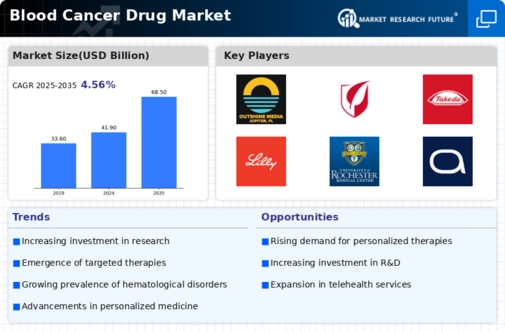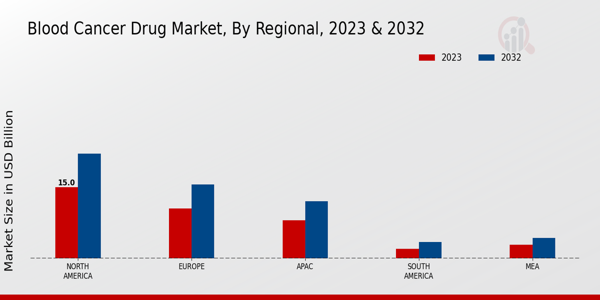Market Trends and Projections
Rising Incidence of Blood Cancers
The Global Blood Cancer Drug Market Industry is experiencing growth due to the increasing incidence of blood cancers such as leukemia, lymphoma, and myeloma. According to the World Health Organization, blood cancers account for a significant portion of cancer cases worldwide, with millions diagnosed annually. This rising prevalence necessitates the development and availability of effective treatment options, driving demand for innovative blood cancer therapies. As the global population ages, the incidence is expected to rise further, contributing to the projected market value of 41.9 USD Billion in 2024 and 68.5 USD Billion by 2035.
Advancements in Targeted Therapies
The Global Blood Cancer Drug Market Industry benefits from advancements in targeted therapies, which have revolutionized treatment paradigms. These therapies, designed to specifically target cancer cells while sparing healthy cells, have shown improved efficacy and reduced side effects. For instance, monoclonal antibodies and small molecule inhibitors are increasingly utilized in clinical practice. The success of these therapies is reflected in the growing number of FDA approvals, which enhances treatment options for patients. As a result, the market is expected to grow at a CAGR of 4.56% from 2025 to 2035, indicating a robust future for targeted blood cancer treatments.
Growing Awareness and Screening Programs
The Global Blood Cancer Drug Market Industry is positively influenced by growing awareness and screening programs aimed at early detection of blood cancers. Educational initiatives and campaigns by health organizations are increasing public knowledge about symptoms and risk factors associated with blood cancers. This heightened awareness encourages individuals to seek medical advice sooner, leading to earlier diagnosis and treatment. Consequently, the demand for blood cancer drugs is expected to rise as more patients are identified and treated. Enhanced screening programs are likely to contribute to the overall growth of the market, ensuring that effective therapies are utilized promptly.
Increased Research and Development Investments
Investment in research and development within the Global Blood Cancer Drug Market Industry is on the rise, driven by both public and private sectors. Governments and pharmaceutical companies are allocating substantial resources to discover novel therapies and improve existing treatments. This commitment is evidenced by numerous clinical trials and collaborations aimed at understanding the complexities of blood cancers. The financial backing facilitates innovation, leading to the introduction of new drugs that can significantly impact patient outcomes. As the market evolves, these investments are likely to play a crucial role in shaping the future landscape of blood cancer therapies.
Emerging Markets and Expanding Access to Treatments
The Global Blood Cancer Drug Market Industry is witnessing growth in emerging markets, where access to cancer treatments is expanding. Countries in Asia-Pacific and Latin America are experiencing improvements in healthcare infrastructure, enabling better access to innovative therapies. As healthcare systems evolve, the availability of blood cancer drugs is increasing, allowing more patients to receive timely treatment. This trend is expected to drive market growth, as the demand for effective blood cancer therapies rises in these regions. The expansion of access to treatments is likely to play a pivotal role in shaping the future of the Global Blood Cancer Drug Market.

























